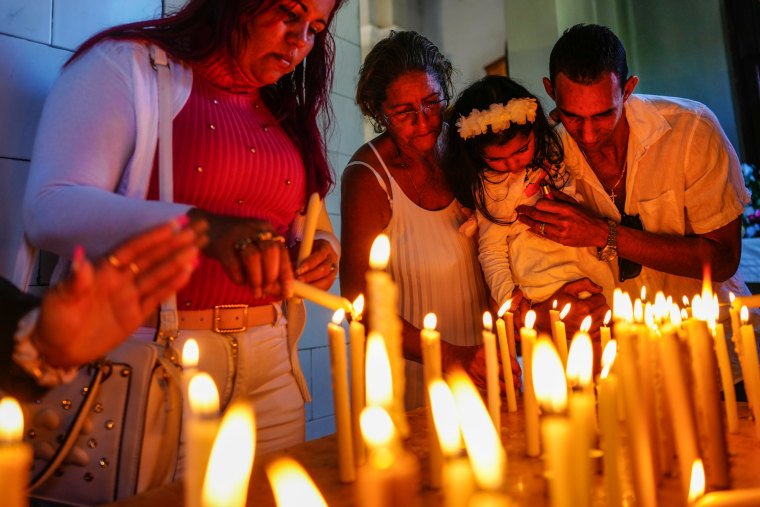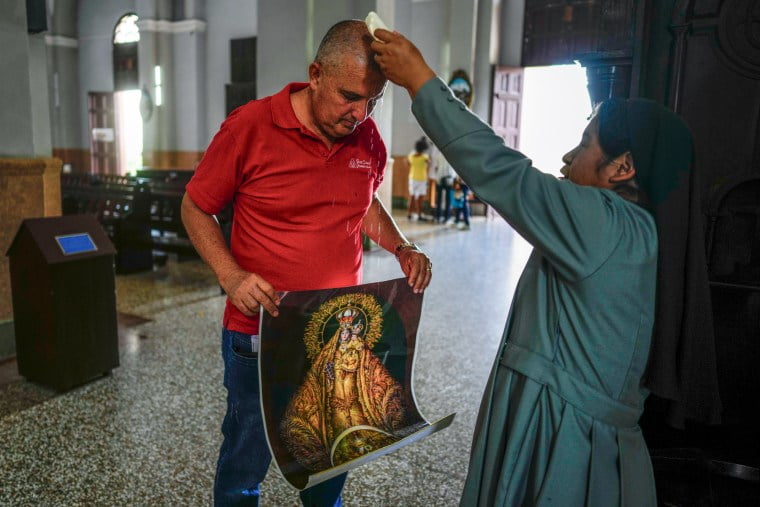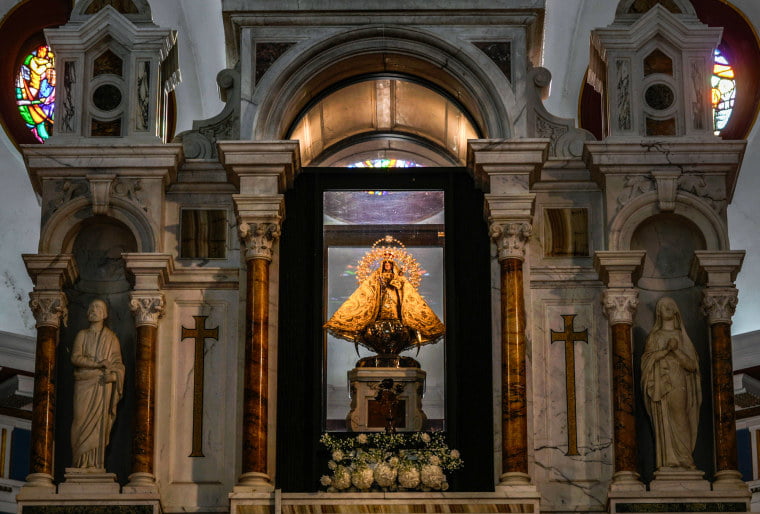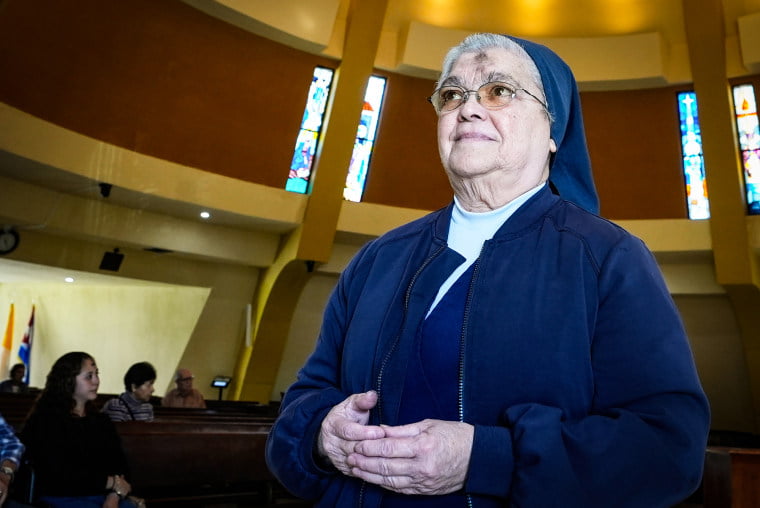At the core of Cuban identity is the Virgin of Charity of Cobre, which unites people who live on the Communist-run Caribbean island with those who were exiled or immigrated to the United States.
In Short
- The virgin of charity of cobre serves as a unifying symbol for cubans, bridging divides between those on the island and those in the diaspora.
- From the shrine in el cobre, cuba, to the miami shrine, her presence is felt deeply in the hearts of believers, offering solace, hope, and a sense of identity.
- Despite political turmoil and geographical distances, devotion to the virgin remains steadfast, shaping the cultural and spiritual landscape of cuba and its diaspora.
TFD – Dive into the rich tapestry of Cuban identity woven around the Virgin of Charity of Cobre, from the island’s devout pilgrims to the diaspora in Miami. Experience the unity and resilience of a people bound by faith and tradition. Join us on this journey of discovery.

EL COBRE, Cuba — Ramon Nieblas stared at the little golden figurine, a cherished representation of the patron saint of Cuba, with sorrowful eyes. He begged the Virgin of Charity of Cobre to perform a miracle and heal his ailing son in a whisper.
“I came to pray for his health,” said Nieblas, a Cuban living in Brazil who traveled thousands of miles to the basilica in eastern Cuba, a pilgrimage site nestled in the shadow of the Sierra Maestra mountains.
He sat at Mass and put his arm around Hernando Nieblas, a 26-year-old doctor who was receiving leukemia treatment. They were among the thousands who visit the shrine each year, seeking intercession from the Virgin Mary for their most desperate concerns and giving thanks for their blessings.

Cuba, an atheist nation after the 1959 revolution, suppressed religious practice; the Virgin of Charity was central to the country’s Catholicism. Over the previous 25 years, it has been increasingly accepting of religious beliefs and became a secular state in the early 1990s.
However, the Virgin of the Vatican, honored by Catholics and adherents of Afro-Cuban Santeria customs, is more than just a religious symbol. She is the central figure in Cuban identity, bringing together fellow citizens of the Communist-run Caribbean nation as well as those who fled or immigrated to the United States.
The parish priest of the basilica, the Rev. Rogelio Dean Puerta, who has previously officiated Mass at the sister shrine in Miami, stated, “The Virgin is deeply entrenched in our culture.” “Discussing Cuba would be incomplete without mentioning the Virgin of Charity.”
Six decades ago, exiles transported a replica of the Virgin to Miami, where it was ultimately used to build the National Shrine of Our Lady of Charity, which is located just south of downtown. Despite political divides among Cubans that date back decades, it continues to be a potent symbol of unification.
On the island, “Cachita,” as she is lovingly called, is depicted in cartoons, street murals, tattoos, and other artwork. on songs, on improvised home altars, and at her shrine some 500 miles (805 kilometers) east of Havana, she is held in high regard.
Cuba’s ivory-colored shrine, adorned with soaring red domes, is decorated with numerous offerings left there, including baby cloths, college degrees, crutches, stethoscopes, handwritten letters, and military insignia, among other items. Famous visitors to the shrine have left mementos such as baseball jerseys, Olympic medals, and other honors.
When the Castro brothers were battling Fulgencio Batista before the revolution, Fidel’s mother once left a little golden figure of a guerilla. A duplicate of Ernest Hemingway’s 1954 Nobel Prize for Literature was also deposited at the Virgin’s feet as a token of gratitude to the Cuban people for inspiring his writings, including “The Old Man and the Sea,” during his two decades of residence in Cuba.
During their pontificates, Popes John Paul II and Benedict XVII made visits to the basilica. Additionally, Pope Francis declared that when he was on the island, he would offer prayers to the Virgin of Charity for Cuba.
A few folks make multiple visits. Ramon Nieblas and his spouse used to visit the shrine to offer prayers for their family many years ago. His wife was diagnosed with cancer this year; together, they have a two-year-old son. “We used to come here to beg the Virgin to allow her to bear that child. “I prayed today that she would be fortunate enough to witness him mature,” he remarked.
Living close to the shrine, Juan Gonzalez offers daily prayers to the Virgin. Statues of Afro-Cuban Santeria deities, whose adherents refer to the Virgin as “Ochun,” the goddess of feminine sexuality and childbirth, adorn his house shrine.
He declared, “I believe in the great power of God and the Virgin of Charity of El Cobre because they are the ones who bless humanity.”
A saint becomes the emblem of the country
The story of the Virgin of Charity of Cobre begins in 1612, when the statue of the Virgin cradling the baby Jesus is reported to have been discovered in the Bay of Nipe by two Indigenous brothers, Juan and Rodrigo de Hoyos, and Juan Moreno, an African lad who was sold into slavery. The basilica claims that it was floating atop a wooden board bearing the inscription, “I am the Virgin of Charity.”

The prominence of the Virgin of Charity has increased during the last four centuries. In the midst of Cuba’s struggle for independence from Spain, she came to represent wounded soldiers, and survivors of that conflict petitioned the Vatican to declare her Cuba’s patron saint.
Michelle Maldonado, a provost at the University of Scranton in Pennsylvania and an authority on the Virgin of Charity, stated, “She became this national symbol.”
In the late 19th century, the veneration of the Virgin of Charity was incorporated into Cuban nationalism. As a protest against the history of religious persecution by the Cuban government, it has gained significant political significance among the Miami-based Cuban diaspora, according to Jorge Duany, head of Florida International University’s Cuban Research Institute.
Many of the early worshippers at Our Lady of Charity fled or were expelled by the Castro government — and reached safety in Florida on rickety rafts like the one featured behind the Virgin’s statue in the Miami shrine’s mural.
The Rev. Angel Andrés González, the vicar of the Miami shrine, observes that the Virgin has been “the connecting thread” in his life, despite the ocean between him from his native country.
“This place in the United States is like the heart of Cuba,” he remarked.
González’s devotion to the Virgin precedes his Catholic religion and serves as the foundation for his life in the United States, much like many of the Cuban exiles who constructed and continue to worship at La Ermita, the name of the Miami shrine.
His mother forced him to chant Hail Marys to a print of the Virgin during thunderstorms, even though his family was mainly nonreligious. It had been hanging behind his bed ever since his baptism in the shrine of Cobre.
Continue to be a lighthouse for immigrants
Longtime Miami residents who view the church as a symbol of defiance against Cuba’s regime as well as recent immigrants hoping to video chat with their mother in Cuba from a familiar location are both welcomed at La Ermita.
During Ash Wednesday ceremonies, which mark the start of Lent, petitions from political refugees and Santeria practitioners were presented to the Miami Virgin. Sister Inés Espinoza tells visitors that the Miami Virgin is a mother who has a gift for each of her children.

The native of Havana and a member of the Daughters of Charity order—which was driven from Cuba in 1972—serves the material and spiritual needs of an increasing number of migrants who arrive at the Ermita as first stop, coming from all across Latin America, including Cuba. The number of Cubans confronted by US border officials in the last few years has exceeded half a million.
Rafael Madlum Payas, a parishioner, loudly cried out for Cuban freedom during an Ash Wednesday Mass as the throng prayed.
According to him, La Ermita provides solace to the 81-year-old political exile, who came to the United States almost two decades ago, since “it means that the Virgin is with us wherever we are.”
In this, he shared a spirit with Yenise Hoyos, a santera who visited the Ermita at the same Mass and brought a figure representing the deity of her Yoruba religion, whom she regards as the virgin’s “sister.”
Hoyos, who immigrated from Cuba four years ago, stated, “What you are, your idiosyncrasy, your religion, never, never gets lost wherever we go.” “When one arrives here, they breathe in an amazing peace.”
Clergy claim that the Virgin keeps the Miami shrine a lighthouse for refugees. The Rev. José Espino, the rector, decided to focus this Lenten sermon on the biblical command to welcome strangers.
Espino stated, “This is always the place to give thanks to the Virgin for a safe arrival.” “She has always accompanied the Cuban people’s dreams.”
For more from NBC Latino, sign up for our weekly newsletter.
Conclusion
The story of the Virgin of Charity of Cobre transcends borders and generations, weaving a tapestry of faith, resilience, and unity among Cubans worldwide. As her light continues to guide the faithful, may her message of hope and solidarity endure, inspiring generations to come.
Connect with us for the Latest, Current, and Breaking News news updates and videos from thefoxdaily.com. The most recent news in the United States, around the world , in business, opinion, technology, politics, and sports, follow Thefoxdaily on X, Facebook, and Instagram .
